“What Golden Rule said was, ‘We are not telling you WHAT to think, but we are saying, in the most dramatic way we can, that there is a NEED to think.’” Albert S. Bigelow, The Voyage of the Golden Rule, 1959.
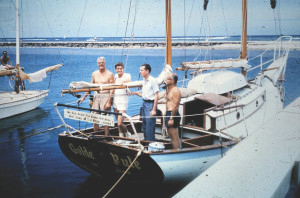
Sailors dream of boats. We conjure up images about the craft that is a thing of utter beauty, sails perfectly, and will carry us to magical places. Some of these dreams are readily achievable, while others are less realistic, if not downright quixotic. This is a story about a sailboat dream that is right up Don Quixote’s alley.
Those of us who dream about the historic ketch Golden Rule may be a bit less realistic than most. On the other hand, the Rule has stirred the imaginations of people ranging far across space and time—from Hiroshima to Connecticut, and the 1950s up to the present. The boat is unusual, and her history even more so.
Lets start with the history. The Golden Rule was the very first of the environmental and peace vessels to go to sea. In 1958, a crew of anti-nuclear weapons activists set sail aboard her in an attempt to interpose themselves and the boat between the U.S. Government and its atmospheric testing of nuclear weapons in the Marshall Islands in the Pacific Ocean.
At that time both the U.S. and the Soviet Union were conducting aboveground tests of very large nuclear weapons, which produced readily detectable clouds of radioactive fallout that wafted around the planet. Radiation contamination began to turn up in cows’ and mothers’ milk. Public concern grew, and for the first time many middle-class Americans began to wonder if their government knew what it was doing.
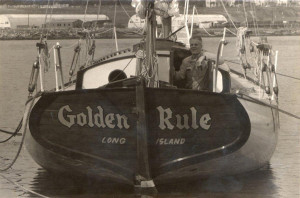
In 1958, the Golden Rule sailed from San Pedro toward the U.S. nuclear test zone at Eniwetok atoll in the Marshall Islands, but she never made it that far. She was twice boarded by the U.S. Coast Guard at Hawaii, and the crew were arrested, tried, and jailed in Honolulu. But, far from being defeated, their example helped to ignite a storm of world-wide public outrage against nuclear weapons that resulted in the Limited Nuclear Test Ban Treaty of 1963, and which has continued down to the present in the many organizations still working to abolish weapons of mass destruction.
The example set by the Golden Rule and her crew was also the inspiration for subsequent environmental and peace voyagers and craft that followed in her wake including the Phoenix of Hiroshima, and later Greenpeace and the Sea Shepherds.
The 50-foot Colin Archer-style ketch Phoenix of Hiroshima, whose owners met Albert S. Bigelow and his crew in Honolulu, was the next boat to carry the mission forward. She sailed to the Marshalls that same year and successfully entered the test zone in protest. The horrors of nuclear war were issues close to the heart of the Phoenix’s skipper, Dr. Earle L. Reynolds. He had been sent to Hiroshima by the U.S. government after World War II to study the effects of nuclear fallout on the growth and development of surviving Japanese children, and was deeply affected by the experience.
The connection to the environmental organization Greenpeace is direct. At a Vancouver meeting of activists in the late 1960s, Marie Bohlen, an American inspired by the Golden Rule’s exploits, suggested a protest voyage toward the U.S. nuclear test site in the Aleutian Islands. The rusty trawler Phyllis Cormack, renamed Greenpeace for the protest, soon headed north and Greenpeace was launched.
Just as importantly, the use of nonviolent direct action as a basic guiding principle of the Golden Rule’s crew would also influence future generations of activists. The seas of the world have never been quite the same since.
It is in their memory of her crew, and the causes that they helped to inspire, that the Veterans For Peace have vowed that the Golden Rule shall again ride the waves of peace.
The Original Crew
A former U.S. naval lieutenant commander, Bigelow was among those most alarmed by nuclear weapons. In 1945, he had had a moment of epiphany when he heard the news of the nuclear destruction of Hiroshima. “It was then,” he recalled, “that I realized for the first time that morally war is impossible.” Later, in the 1950s, he joined the Religious Society of Friends (Quakers) and adopted their principles of nonviolence.
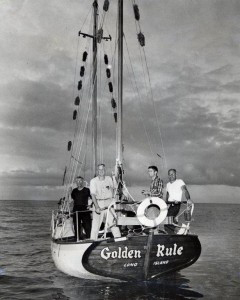
Bigelow had also been deeply affected by his family’s experience hosting several of the “Hiroshima Maidens,” women who had come to the U.S. for medical treatment after being terribly injured in the nuclear blasts over Japan in 1945. Bigelow firmly believed that the nuclear arms race was nothing more than a “race to extinction” that had to be stopped.
Deciding that action was called for, he and others joined the National Committee for a Sane Nuclear Policy (SANE) in 1957. At first, SANE went through normal channels, petitioning the U.S. Government and requesting meetings with officials. When that strategy brought no result, it was decided that more direct action was called for. Thus was born the voyage of the Golden Rule, and the age of the modern protest vessel.
In keeping with their Quaker beliefs, Bigelow and the others came up with what was then a novel approach: they would sail a small craft into the test zone in the Marshall Islands, risking their own lives to do so. At the same time, they determined that their protest would not be done in secret, but in the full light of day; and that a basic principle of their actions should be the fullest respect for the humanity of their opponents. In January of 1958, they wrote President Eisenhower of their plans.
“How do you reach men,” Bigelow wrote, “when all the horror is in the fact that they feel no horror? It requires, we believe, the kind of effort and sacrifice that we now undertake.”
It is easy to focus on Bigelow when describing the voyage of the Golden Rule. He was, after all, the author of the book by that name. But he would have been the first to point out that the other crew members were noteworthy in their own right, and that was indeed the case.
William Huntington was an architect, a Quaker, an international aid official with the American Friends Service Committee, and a Quaker representative to the United Nations. He had been a conscientious objector during World War II and was an experienced sailor. George Willoughby was also a well-known peace activist, a nonviolent war resister who seemed always to be at the center of the action. He went on to co-found Peace Brigades International and the Philadelphia-based Movement for a New Society, dedicated to nonviolent social transformation.
At 28 years of age, Orion Sherwood was the youngest of the Golden Rule’s crew, and the only Methodist. Prior to that, he had been a teacher at a Friends school in Poughkeepsie, New York. Known for his gentle disposition, he was also a graduate engineer, and had studied for the ministry. After the voyage, he returned to teaching at a Friends school in New Hampshire.
James Peck, although not a Quaker, had been a long-time practitioner of nonviolent direct action, a conscientious objector in World War II, and a fierce advocate of racial equality. He fought for civil rights for African Americans while in prison during the war, and in the U.S. Navy and merchant marine. In 1938, he was a founder of what would later become the National Maritime Union. Peck joined the crew in Hawaii.
Both Peck and Bigelow later were among the original 13 Freedom Riders who in 1961 risked their lives to desegregate interstate public transportation in the American South. Peck was savagely beaten by a Ku Klux Klan mob, and Bigelow placed his own body between a mob and John Lewis, absorbing some of the blows intended for the man who would later become one of Georgia’s U.S. representatives. Lewis recounted the story at the 2012 Democratic National Convention. In 1961, “Albert Bigelow and I tried to enter a white waiting room, we were met by an angry mob that beat us and left us lying in a pool of blood. Some police officers came up and asked us whether we wanted to press charges. We said, ‘No, we come in peace, love, and nonviolence.’”
Bigelow appears to have been the only member of the Golden Rule’s crew who later remained passionate about the sea and sailing. Returning home to Cos Cob, Connecticut, he became a painter along mostly nautical themes. A number of his works are among the holdings of the Mystic Seaport Museum. He continued to sail and teach the sport. In 1993, the Southern Massachusetts Sailing Association established an award in his honor, to the junior sailor with an “enthusiasm for fair sailing.”
The Boat is Lost Then Found
The nonviolent action group sold Golden Rule in Hawaii late in 1958. Her whereabouts after that are somewhat unclear until she later turned up in Eureka, California, in a state of bad neglect—so much so that she finally sank in a storm in 2010. She was raised from the depths by shipyard owner Leroy Zerlang.
Zerlang has had a lifelong love affair with Humboldt Bay’s history and its classic wooden boats. Among his many projects are the local maritime museum, and its 100-year-old tour boat Madaket which, built in 1910, is the last of the Humboldt ferries and the oldest passenger vessel in continuous service in the United States. Zerlang also takes in strays at the boatyard including dogs and cats, a horse, Gilou the goat, and even the odd political scientist (that would be me). He has a gruff exterior, beneath which lies an equally gruff interior. Although not much of a peacenik, he is coming around.
So given that background, it should hardly be surprising that when the badly neglected Golden Rule sank in a storm in 2010 off Zerlang’s boatyard, he decided to raise her and find people who would restore the boat to her former glory. After doing some research on the boat’s background, he was startled to learn that the Golden Rule had played an important role in the history of the Cold War. He put some feelers out and was contacted by the Smithsonian Institute, several historians, and finally by Veterans For Peace.
One day in 2010, longtime Veterans For Peace activists (and non-sailors) Fredy and Sherry Champagne wandered into the Zerlang boatyard. They had heard something vague about a peace boat in need of restoration at that location. Fredy swears that, when he put his hand on her keel, the boat spoke to him, asking for another life. Wandering over to a somewhat puzzled looking Zerlang (they had never met), Fredy and Sherry asked whether he would provide yard space and facilities if the Veterans For Peace did the restoration. They shook hands on the spot, and thus began the revival of the Golden Rule.
In an eerie coincidence, the Phoenix of Hiroshima was also discovered sunk and neglected in California waters in 2010. She was at the bottom of the Sacramento River, gutted and mastless, discovered as a result of an ad on Craigslist (Free: 50-foot yacht!). The Reynolds family and others are organizing an effort to raise and restore the boat.
The Restorers
The Golden Rule restoration team is an eclectic mix of sailors, shipwrights, historic boat lovers, and peaceniks.
The project’s master shipwright is David Peterson, widely acknowledged to be the most talented wooden boat restorer on Humboldt Bay. He advises boatwright Breckin Van Veldhuizen, a recent graduate of the Northwest School of Wooden Boatbuilding near Port Townsend, Washington. Although a stranger to anti-nuclear activism, she loves sailing and working with wood and boats. To her, the three words that every woman should most want to hear are, “Let’s go sailing!”
The swizzle that stirs the Golden Rule Project cocktail is Navy veteran Chuck DeWitt, the restoration coordinator. DeWitt puts countless hours into making sure that the necessary tools and supplies are available to the team working on the boat. He is also involved in fundraising and publicity. Among his other pursuits are volunteering for the Humboldt Baykeepers in their efforts to preserve and protect coastal resources, and taking part in a weekly Veterans For Peace vigil outside the Humboldt County courthouse in Eureka on Friday evenings. He’s been doing that for nearly ten years, having been outraged by the events leading up to the 2003 U.S. invasion of Iraq.
Former high school all-American linebacker, Mike Gonzalez of Trinidad began volunteering in mid-2012. As a talented wood sculptor and sailor, he brings much-needed skills to the project. If you ask him why he volunteers, he responds that he is a big believer in “peace, love, and freedom,” and that to him sailing and the Golden Rule embody all three. He dreams of sailing out of Humboldt Bay on a new mission of peace.
The Golden Rule’s welding and metal fabricating are ably handled by Dennis Thompson, a retiree from the military who lives aboard Andromeda, a 44-foot steel-hulled sloop that he built and welded by himself. Andromeda is docked at the city marina in Eureka.
As of this writing (April 2012) the restoration is moving ahead briskly. Volunteers and shipwrights are on the job almost daily. The hull has been replanked and faired, coated with primer, and is nearly ready for final painting. A new Yanmar diesel engine has been purchased, and a new prop, shaft, and bearing box are on-hand and ready to install. A new stainless-steel fuel tank has been fabricated and installed. Fore and aft bulkheads are in, and the cabin roof and decks are complete.
The wooden spars (main and mizzen mast, booms and gaffs) are being built, and the rudder and tiller are being restored. The interior is starting to go in, along with the electrical system. Captain Zerlang is even building a small foundry to make a new ship’s bell and other hardware. While much remains to be done, tremendous progress has already been made.
There is a good chance that the re-launch of the restored Golden Rule will take place in 2013. As date of the completion of the restoration project approaches, the excitement at the boatyard is palpable.
The Original Boat
The Golden Rule is a Hugh Angelman and Charles Davies-designed Alpha-30 ketch. The hull was constructed in Costa Rica, and the final build was by Les Marsh’s “Posami” company in San Pedro around 1957. In his book, The Voyage of the Golden Rule, Bigelow described the boat as a “character vessel,” with a “jaunty, rakish look.” She is a ketch with a gaff-rigged main and masts raked sharply aft. The engine was a 25-horsepower “Atomic 4,” a name that gave rise to humorous consternation among the anti-nuclear crew.
Like all sailboats, the Golden Rule design was the product of compromises, with its particular limitations and flaws. Bigelow noted that it had been built with coastal cruising in mind; and the built-in ice chest, large cockpit, and sink were not ideal for blue water passages. The long bowsprit added looks and character to the boat, but entailed additional risk to the crew.
More seriously, the gaff-rigged mainsail could not be permanently stayed aft, which resulted in a slack forestay and mediocre sailing to windward. The rig’s design made it difficult to stay the masts to the rear, and serious chafe issues were the result. Somehow, during construction, limber holes had not been drilled in the bilge frames, which meant that standing water became trapped, and the boat could not be pumped dry. In spite of these issues, Bigelow called the Golden Rule a “stout and able vessel” that served them well.
The End of the Beginning
The restoration of historic sailing craft is new to Veterans For Peace, and we are still working to get our minds around the idea. But to this nonviolent group, the Golden Rule is such an important symbol of resistance to war that we believe she is worthy of preservation. Thus, the Golden Rule restoration was adopted as a national project of Veterans For Peace in 2012.
With the able help of many volunteers and supporters, the goal is to refloat the Golden Rule in 2013 and launch a ten-year voyage in opposition to war and militarism, as well as to illuminate a key chapter of American history.
After all, if one is going to dream of boats, why dream small? Among other peace- and justice-oriented goals, part of the mission of Veterans For Peace is to work to abolish war as an instrument of U.S. national policy. For the Golden Rule Project, these two dreams are irrefutably intertwined.
The website at VFPGoldenRuleProject.org has information on where to donate, other items that are needed, and updates on the progress of the restoration.


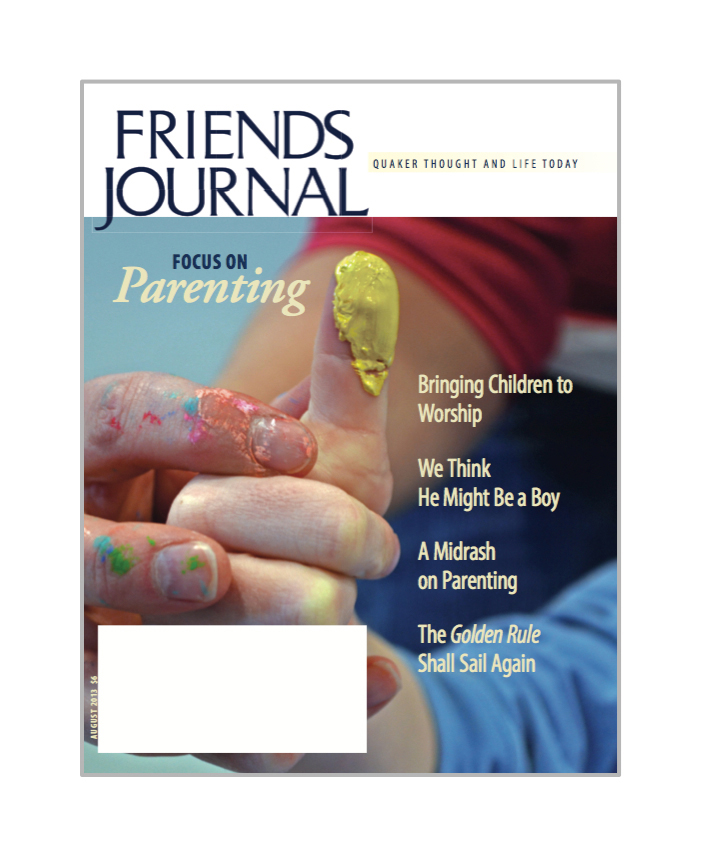
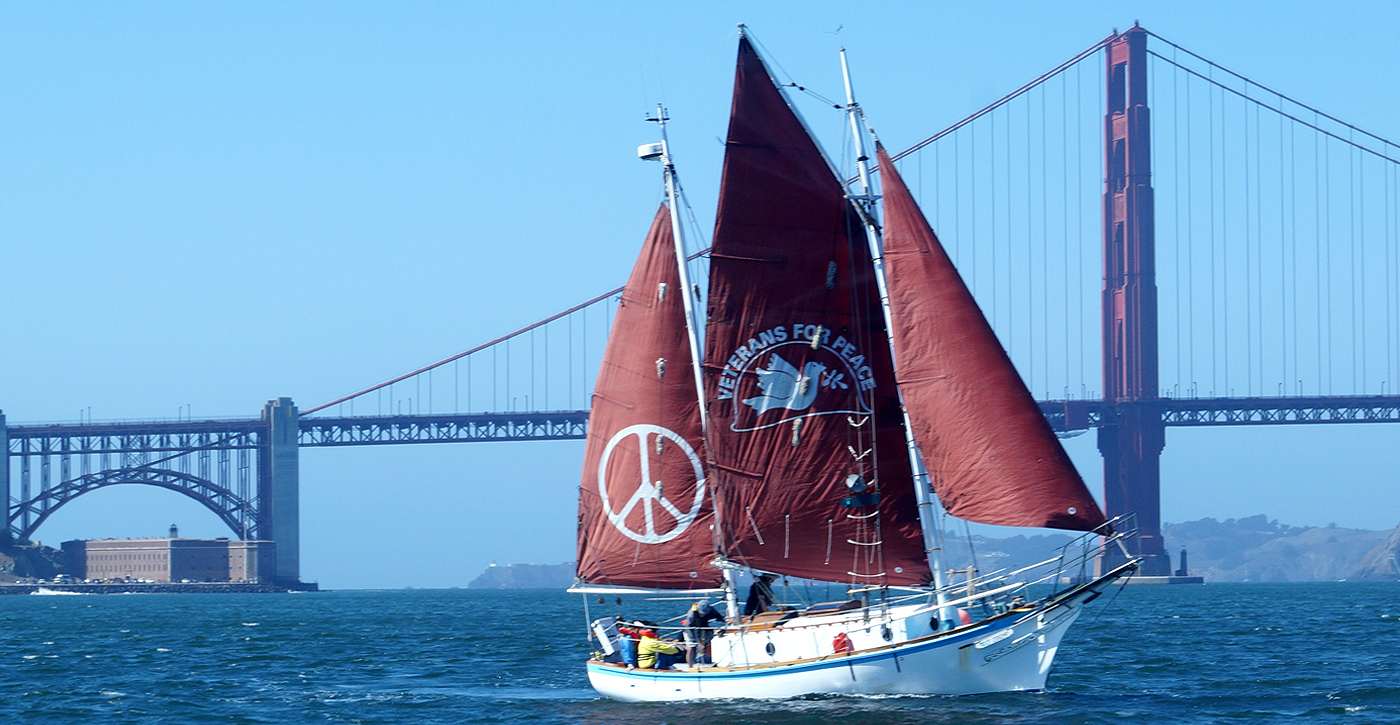
At the Golden Rule Project, we have search and found many relatives and supporters of the Golden Rule ketch. We have not yet been able to locate relatives of Orion Sherwood. We any the Friends if someone could connect us so that we may invite the Sherwoods to our re-launch celebration we have been planning. We would sincerely like to honor the crew members, and hope all friends and those associated with this Golden Rule Protest Yacht will contact us and be present for the re-launch.
[…] Rule, a ship that protested United States nuclear testing in the Pacific. To learn more, read The Golden Rule Shall Sail Again in the August 2013 issue of Friends […]
[…] remarkable story of the Golden Rule began with Albert Bigelow, a retired World War II U.S. naval commander. Appalled […]
[…] remarkable story of the Golden Rule began with Albert Bigelow, a retired World War II U.S. naval commander. Appalled […]
[…] remarkable story of the Golden Rule began with Albert Bigelow, a retired World War II U.S. naval commander. Appalled by the atomic […]
[…] The remarkable story of the Golden Rule began with Albert Bigelow, a retired World War II U.S. naval commander. Appalled by the atomic bombing of Hiroshima, he became a Quaker and, in 1955, working with the American Friends Service Committee, sought to deliver a petition against nuclear testing to the White House. Rebuffed by government officials, Bigelow and other pacifists organized a small group, Non-Violent Action Against Nuclear Weapons, to employ nonviolent resistance in the struggle against the Bomb. After the U.S. government announced plans to set off nuclear bomb blasts near Eniwetok in the Marshall Islands ― an island chain governed by the United States as a “trust territory” for the native people ― Bigelow and other pacifists decided to sail a 30-foot protest vessel, the Golden Rule, into the nuclear testing zone. Explaining their decision, Bigelow declared: “All nuclear explosions are monstrous, evil, unworthy of human beings.” […]
[…] remarkable story of the Golden Rule began with Albert Bigelow, a retired World War II U.S. naval commander. Appalled by the atomic […]
[…] remarkable story of the Golden Rule began with Albert Bigelow, a retired World War II U.S. naval commander. Appalled by the atomic […]
[…] remarkable story of the Golden Rule began with Albert Bigelow, a retired World War II U.S. naval commander. Appalled by the atomic […]
[…] testing and nuclear war was inspired by an American peace ship, the Golden Rule. The remarkable story of the Golden Rule began with Albert Bigelow, a retired World War II U.S. naval commander. Appalled by the atomic […]
[…] remarkable story of the Golden Rule began with Albert Bigelow, a retired World War II U.S. naval commander. Appalled by the atomic […]
[…] The remarkable story of the Golden Rule began with Albert Bigelow, a retired World War II U.S. naval commander. Appalled by the atomic bombing of Hiroshima, he became a Quaker and, in 1955, working with the American Friends Service Committee, sought to deliver a petition against nuclear testing to the White House. Rebuffed by government officials, Bigelow and other pacifists organized a small group, Non-Violent Action Against Nuclear Weapons, to employ nonviolent resistance in the struggle against the Bomb. After the U.S. government announced plans to set off nuclear bomb blasts near Eniwetok in the Marshall Islands ― an island chain governed by the United States as a “trust territory” for the native people ― Bigelow and other pacifists decided to sail a 30-foot protest vessel, the Golden Rule, into the nuclear testing zone. Explaining their decision, Bigelow declared: “All nuclear explosions are monstrous, evil, unworthy of human beings.” […]
My uncle bought the Golden Rule in 1959 when the original crew was in Honolulu jail for stating they would sail to Eniwetok in protest of the atomic tests. They were arrested and jailed. My uncle had met them in California and said he wanted the boat if/when they were done with it. My uncle renamed the boat the Pu’ori (Tahitian for “wanderer”) and he and I plus a Canadian man sailed the boat from Honolulu to the Marquesas, the Tuamotus, and the Societies (Tahiti) in 1958-59. That was the most memorable 9 months of my life!!!
[…] a symbol and a classroom for instruction against the manufacture and use of nuclear weapons. See https://oldfj.wpengine.com/the-golden-rule-shall-sail-again/ and http://harvardmagazine.com/2013/07/vita-albert-bigelow The example set by the Golden Rule and […]
[…] The Golden Rule Shall Sail Again […]
[…] first contemplated restoration, and a longer followup by Arnold (Skip) Oliver in 2014, The Golden Rule Shall Sail Again. Of course, the cool thing about working at a established magazine is that it was easy for […]
[…] be stopped, it is at least exposed. Anti-nuclear Quaker campaigns (which started with the voyage of the Golden Rule in 1958) played a key role in inspiring the formation of Greenpeace (in 1971), which adopted […]